

Access to Digital Resources and Services: An Interpretation of the Library Bill of Rights. The fundamental mission of libraries is to provide access to information, regardless of content or format, to everyone.
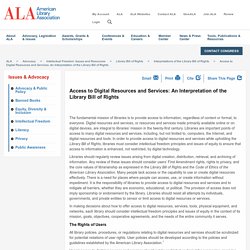
Digital resources and services, or resources and services made primarily available online or on digital devices, are integral to libraries’ mission in the twenty-first century. Libraries are important points of access to many digital resources and services, including, but not limited to, computers, the Internet, and digital resources and tools. In order to provide access to digital resources and services while upholding the Library Bill of Rights, libraries must consider intellectual freedom principles and issues of equity to ensure that access to information is enhanced, not restricted, by digital technology. Libraries should regularly review issues arising from digital creation, distribution, retrieval, and archiving of information.
The Rights of Users. Assistive Technology – ASGCLA Direct. Overview “Assistive technology” is a term that describes electronic solutions that enable people with disabilities to live independently.
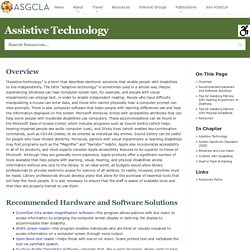
The term “adaptive technology” is sometimes used in a similar way. UD in Mamaroneck Schools. "Within a period of 10 years, UDL has captured the imagination of policy makers, researchers, administrators, and teachers.
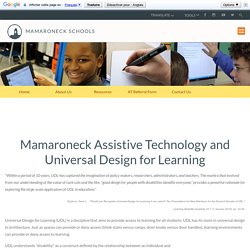
The mantra that evolved from our understanding of the value of curb cuts and the like, “good design for people with disabilities benefits everyone,” provides a powerful rationale for exploring the large-scale application of UDL in education. " Edyburn, Dave L. . "Would you Recognize Universal Design for Learning if you saw it? Ten Propositions for New Directions for the Second Decade of UDL. "Learning Disability Quarterly 33 1 (1 January 2010): pp. 33-39. School Librarians of the 21st Century: Using Resources and Assistive Technologies to Support Students' Differences and Abilities. How Universal Design Will Make Your Library More Inclusive. Centre for Excellence in Universal Design. The 7 Principles of Universal Design were developed in 1997 by a working group of architects, product designers, engineers and environmental design researchers, led by the late Ronald Mace in the North Carolina State University.The purpose of the Principles is to guide the design of environments, products and communications.
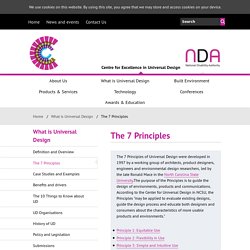
According to the Center for Universal Design in NCSU, the Principles "may be applied to evaluate existing designs, guide the design process and educate both designers and consumers about the characteristics of more usable products and environments. " Principle 1: Equitable UseThe design is useful and marketable to people with diverse abilities. Guidelines: 1a.
Provide the same means of use for all users: identical whenever possible; equivalent when not. 1b. 1c. 1d. Principle 2: Flexibility in UseThe design accommodates a wide range of individual preferences and abilities. 2a. 2b. 2c. 7 Principals of Universal Design in Detail. Using Technology to Empower Students with Special Needs. Technology in the classroom can serve as a great equalizer.
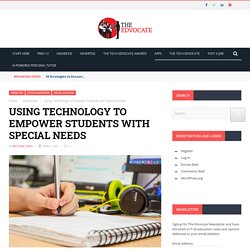
Access CS for All. AccessCSforAll (formerly AccessCS10K) works to increase the successful participation of students with disabilities in K-12 computing.
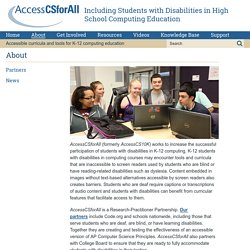
K-12 students with disabilities in computing courses may encounter tools and curricula that are inaccessible to screen readers used by students who are blind or have reading-related disabilities such as dyslexia. Content embedded in images without text-based alternatives accessible by screen readers also creates barriers.
2018 YALSA EDI Plan. IT with LD - NCLD. I was diagnosed with ADHD when I was very young.
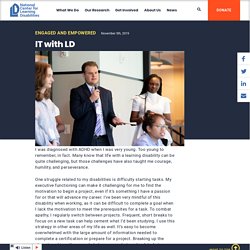
Too young to remember, in fact. Many know that life with a learning disability can be quite challenging, but those challenges have also taught me courage, humility, and perseverance. One struggle related to my disabilities is difficulty starting tasks. My executive functioning can make it challenging for me to find the motivation to begin a project, even if it’s something I have a passion for or that will advance my career. I’ve been very mindful of this disability when working, as it can be difficult to complete a goal when I lack the motivation to meet the prerequisites for a task.
How special education technology improves learning. Using Technology to Empower Students With Special Needs. One of the biggest problems I encounter as a resource room teacher is the self-esteem of the students in my classes.

After years of disappointing academic experiences, their confidence is low and their motivation has declined. Combine those points with the peer pressure, bullying, and stresses of middle school, and the students do not have a positive outlook on their education. In my classroom, technology is a tool for empowerment—it creates a collaborative and innovative space for all students.
Digital tools for kids with special needs. You might think that with all the talk about customizing digital tools for young children with individual needs, we'd hear even more about specific technologies that can help.
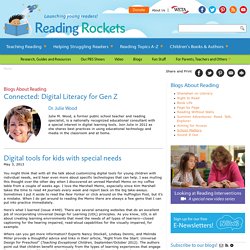
I was mulling this thought over the other day when I discovered an unread Marshall Memo on my coffee table from a couple of weeks ago. I love the Marshall Memo, especially since Kim Marshall takes the time to read 44 journals every week and report back on the big take-aways. Sometimes I put it aside to read the New Yorker or click around on the Huffington Post, but it's a mistake. When I do get around to reading the Memo there are always a few gems that I can put into practice immediately. Here's what I learned (issue #449). Where can you get more information? Oh, and one more!